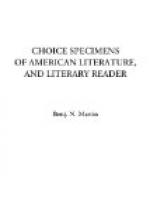What would we not give for a newspaper of the days of Homer, with personal recollections of the contractors and commanders in the siege of Troy; a reminiscence of Helen; the unedited fragments of Nestor; or a traditional saying of Ulysses, who may be supposed too wise to have published? What such a passage of literature would be to us, the journal of to-day may be to some long distant age, when it is disentombed from the crumbling corner-stone of some Astor House, Exchange, or Trinity Church, on the deserted shore of an island, once New York. What matters of curiosity would be poured fourth for the attention of the inquisitive; how many learned theories which had sprung up in the interim, put to rest; what anxiety moralists would be under to know the number of churches, the bookseller’s advertisements, and the convictions at the Sessions! Some might be supposed to sigh over our lack of improvement, the infant state of the arts, and our ineffectual attempts at electro-magnetism, while others would dwell upon the old times when Broadway was gayer with life, and the world got along better, than it has ever done since.
* * * * *
=_Horace Binney Wallace,[55] 1817-1852._=
From “Art, Scenery, and Philosophy in Europe.”
=_230._= ART AN EMANATION OF RELIGIOUS AFFECTION.
The spirit, conscious of an emotion of reverence for some unseen subject of its own apprehension, desires to substantiate and fix its deity, and to bring the senses into the same adoring attitude; and this can be done only by setting before them a material representation of the divine. This is illustrated in the universal and inveterate tendency of early nations to idolatry....
How and why was it that the sculpture of the Greeks attained a character so exalted that it shines on through our time, with a beam of glory peculiar and inextinguishable? When we enter the chambers of the Vatican, we are presently struck with the mystic influence that rays from those silent forms that stand ranged along the walls. Like the moral prestige that might encircle the vital presence of divine beings, we behold divinities represented in human shapes idealized into a significance altogether irresistible. What constitutes that idealizing modification we know not; but we feel that it imparts to the figures an interest and impressiveness which natural forms possess not. These sculptured images seem directly to address the imagination. They do not suffer the cold and critical survey of the eye, but awaken an instant and vivid mental consideration.




